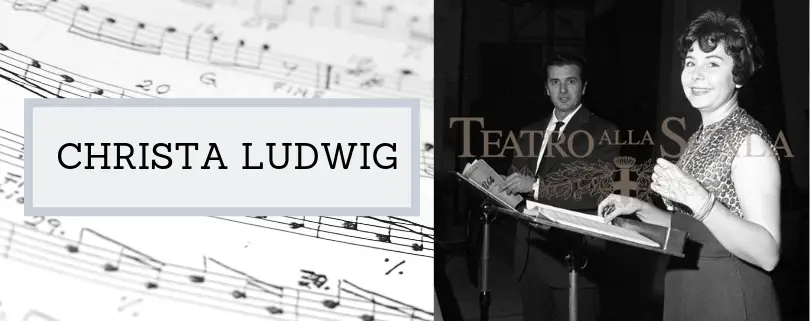Christa Ludwig, Mezzosoprano – opera guide
The online operaguide on Christa Ludwig
Read the short biography of Christa Ludwig and listen to Highlights of her career. Christa Ludwig is a german mezzosoprano and considered to be one of the outstanding opera singers of the post-war period and one of the most important mezzo-sopranos of the 20th century.
The ascent
Christa Ludwig was born on 16 March 1928 in Berlin and is a German opera and concert singer. She was born into a musical family. She made her debut in Frankfurt at the age of 18. In the mid 50s she went to the famous conductor Karl Böhm in the Vienna State Opera. In 1955 she made recordings with Schwarzkopf and Legge and started singing the great Mozart and Strauss arias like le nozze di figaro.
In the sixties one of the highlights was the Fidelio recording with Klemperer.
Abscheulicher!… Komm Hoffnung – Christa Ludwig
Her stage activity
Christa Ludwig’s repertoire was huge. Besides the mezzo roles she sang parts from the Italian repertoire and made many excursions in the highly dramatic fach. She was performing for 30 years at the Met and for 35 years at the Vienna State Opera. In addition to her opera activities, she also sang many lieder, especially in the second half of her career. In 1994 gave her farewell from the stage.
I am easily assimilated (Candide) – Ludwig
Her voice
The mezzo is radiant in the high register of is lush in the mezzo and alto register. It has the sensual timbre of an erotic voice, ideal for a cherubino (Kesting)
Conductors
She has spoken several times about her work with conductors. Karajan taught her to listen to beauty, to strive for the most beautiful phrasing and the fusion with the orchestra. Böhm was a fanatic of rhythm and Bernstein taught her to go into “the depth of music” with his slow tempi.
Prenderò quell brunettino (Cosi fan tutte) – Ludwig / della Casa / Böhm
Impact
Christa Ludwig is considered one of the outstanding singers of the post-war period and one of the most important mezzo-sopranos of the 20th century. Her Fidelio with Klemperer and Rosenkavalier with Karajan have lasting significance.
Mir ist die Ehre wiederfahren (Rosenkavalier) – Ludwig / Stich-Randall / Karajan
Highlights from recordings
We hear “Non so piu cosa faccio”. Jürgen Kesting comments: “Ludwig’s Mezzo, radiant in the high register, rich in sound in the mezzo and alto registers, sensual in the iridescent splendour of the timbre, is a decidedly erotic voice, ideal for the groping Eros of Cherubino. Kaiser is also enthusiastic about Christa Ludwig’s Cherubino and the recording with Böhm “because of Ludwig as Cherubino one has to love this recording”.
Non so piu cosa faccio
This trio from Cosi fan tutte is one of Mozart’s absolutely greatest vocal pieces, he takes us into a supernatural world. Mozart accompanies the three voices with muted strings that imitate gentle waves. You will hear this trio in an interpretation by Christa Ludwig and Elisabeth Schwarzkopf and Walter Berry. This recording is taken from the legendary Cosi fan tutte recording produced by Walter Legge.
Soave sia il vento – Schwarzkopf / Ludwig / Berry
You hear a wonderful recording of this duo from Cosi fan tutte with the dream cast Christa Ludwig and Elisabeth Schwarzkopf with the tender but never sweet accompaniment of Karl Böhm.
Ah, che tutta in un momento – Ludwig / Schwarzkopf
This duet is also called the Flower Duet and the atmosphere changes with a fast waltz-like melody into a buoyant, cheerful mood. Experience this scene, impressively filmed with Mirella Freni and Christa Ludwig. You will find the flower duet from 1:35:14.
Scuoti quella fronde di ciliegio – Freni / Ludwig
Wagner composed twenty minutes of music for the this scene of Elsa and Ortrud. We hear this passage in 3 sections. We start with the balcony scene of Elsa. In this section we hear an absolute dream cast. Hardly any singer could bring so much warmth into her voice as Elisabeth Grümmer (Elsa) and Christa Ludwig (Ortrud) showed a great Ortrud in several recordings.
Euch Lüften, die mein Klagen – Grümmer / Ludwig
We hear again Elisabeth Grümmer and Christa Ludwig, in one of Richard Wagner’s most beautiful duets.
Du ärmste kannst wohl nicht ermessen – Grümmer / Ludwig
Ludwig was a great performer of the role of the witch in Hänsel und Gretel. Her enticing singing is great. She combines the spookiness with beautiful singing and joy of playing. Listen to the scene from 1:18:55 to 1:22:10.
Kommt kleine Mäuslein, kommt in mein Häuslein (1:18:55 – 1:22:10) – Ludwig / Moffo
From Wagner’s Tannhäuser: We hear a vocally colourful and lush Venus from Christa Ludwig.
Geliebter, Komm! Sieh dort die Grotte! – Ludwig
Wagner composed twenty minutes of music for the this scene of Elsa and Ortrud. We hear with the balcony scene of Elsa. In this section we hear an absolute dream cast. Hardly any singer could bring so much warmth into her voice as Elisabeth Grümmer (Elsa) and Christa Ludwig (Ortrud) showed a great Ortrud in several recordings.
Euch Lüften, die mein Klagen – Grümmer / Ludwig
This duet is said to bear a likeness to Bellini’s music. In fact, Wagner respected the Sicilian for his gentle melodies. Wagner has seen Bellini’s “Romeo and Juliet work” (titled “I Capuleti e Montecchi”) several times and was deeply impressed. The duets between the soprano and the mezzo of this opera (Romeo is a trouser part) were probably a model for this scene. By chance (or not) in the first part of this scene Ortrud calls Elsa, who is standing on a balcony (!!!), with enticing, ornamented singing. Towards the end of the duet the two voices unite in best Italian manner – a great scene. We hear again Elisabeth Grümmer and Christa Ludwig, in one of Richard Wagner’s most beautiful duets.
Du ärmste kannst wohl nicht ermessen – Grümmer / Ludwig
Next, we hear a brilliant recording of Christa Ludwig of Countess Eboli from “Don Carlo”. She confessed that this dramatic part took her to the limits, especially the passages with high notes. We learn an exemplary story from Kesting’s book: “How this can end was shown in August 1975 in a Salzburg performance under Karajan when she failed at the end of the Eboli Aria. She herself said that she had “not succeeded in striking the last note of my great aria, but the fact that she left after the audience booed her, and that she did not sing at the second performance, shows the enormous nervous strain of the best.
O don fatale
This further stunning piece from Berstein’s Candide is a flamenco. The old lady speaks of her origin from Rovno Gobernia. This is not a geographical indication Voltaire’s, but an idea of Bernstein. Rovno Gobernia was the birthplace of his father who emigrated from Russia. The text of this play is by Bernstein himself. An anecdote says that he couldn’t find a rhyme for Rovno Gobernia when writing the text and complained to his (Spanish speaking wife) Felicia about it. Since the old lady sings Spanish in this flamenco, Felicia spontaneously came up with the hilarious verse “me muero me sale una hernia” (I am dying and growing a hernia).
We hear this piece in a wonderful interpretation by Christa Ludwig.
I was not born in sunny hispania … I am so easily assimilated
This famous piece is set in a slow dance music that appears in the gloomy dress of the minor key. This contrast between the cheerful rhythm and the gloomy mood is what makes this piece so charming. It is the depth of the role of the Marschallin that gives the Rosenkavalier the profundity that it raises above the aristocratic farce. The Marschallin is an “alter ego” of the Countess from Mozart’s marriage to Figaro, one almost thinks the Countess has awakened again. Christa Ludwig was a great Marschallin. She sang the role in a recording by Leonard Bernstein, which was completely different from Karajan’s recording (in which Ludwig sang Octavian). Ludwig has a more opulent voice than her colleague Elisabeth Schwarzkopf, especially in the low and middle registers.
Die Zeit ist ein sonderbares Ding – Ludwig
Peter Lutz, opera-inside, the online operaguide to Christa Ludwig




Leave a Reply
Want to join the discussion?Feel free to contribute!